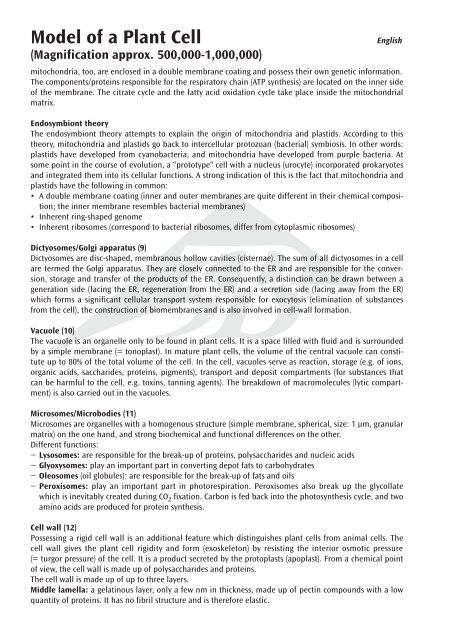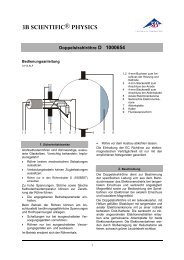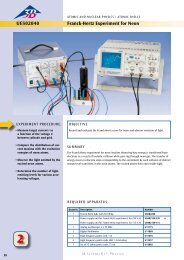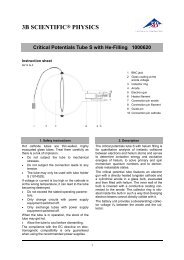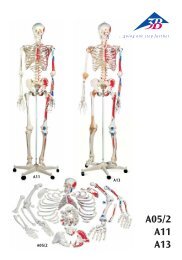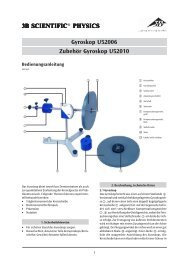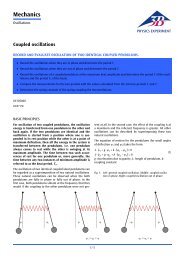Modelo de la célula vegetal - 3B Scientific
Modelo de la célula vegetal - 3B Scientific
Modelo de la célula vegetal - 3B Scientific
You also want an ePaper? Increase the reach of your titles
YUMPU automatically turns print PDFs into web optimized ePapers that Google loves.
Mo<strong>de</strong>l of a P<strong>la</strong>nt Cell<br />
(Magnification approx. 500,000-1,000,000)<br />
English<br />
mitochondria, too, are enclosed in a double membrane coating and possess their own genetic information.<br />
The components/proteins responsible for the respiratory chain (ATP synthesis) are located on the inner si<strong>de</strong><br />
of the membrane. The citrate cycle and the fatty acid oxidation cycle take p<strong>la</strong>ce insi<strong>de</strong> the mitochondrial<br />
matrix.<br />
Endosymbiont theory<br />
The endosymbiont theory attempts to exp<strong>la</strong>in the origin of mitochondria and p<strong>la</strong>stids. According to this<br />
theory, mitochondria and p<strong>la</strong>stids go back to intercellu<strong>la</strong>r protozoan (bacterial) symbiosis. In other words:<br />
p<strong>la</strong>stids have <strong>de</strong>veloped from cyanobacteria, and mitochondria have <strong>de</strong>veloped from purple bacteria. At<br />
some point in the course of evolution, a “prototype“ cell with a nucleus (urocyte) incorporated prokaryotes<br />
and integrated them into its cellu<strong>la</strong>r functions. A strong indication of this is the fact that mitochondria and<br />
p<strong>la</strong>stids have the following in common:<br />
• A double membrane coating (inner and outer membranes are quite different in their chemical composition;<br />
the inner membrane resembles bacterial membranes)<br />
• Inherent ring-shaped genome<br />
• Inherent ribosomes (correspond to bacterial ribosomes, differ from cytop<strong>la</strong>smic ribosomes)<br />
Dictyosomes/Golgi apparatus (9)<br />
Dictyosomes are disc-shaped, membranous hollow cavities (cisternae). The sum of all dictyosomes in a cell<br />
are termed the Golgi apparatus. They are closely connected to the ER and are responsible for the conversion,<br />
storage and transfer of the products of the ER. Consequently, a distinction can be drawn between a<br />
generation si<strong>de</strong> (facing the ER, regeneration from the ER) and a secretion si<strong>de</strong> (facing away from the ER)<br />
which forms a significant cellu<strong>la</strong>r transport system responsible for exocytosis ® (elimination of substances<br />
from the cell), the construction of biomembranes and is also involved in cell-wall formation.<br />
Vacuole (10)<br />
The vacuole is an organelle only to be found in p<strong>la</strong>nt cells. It is a space filled with fluid and is surroun<strong>de</strong>d<br />
by a simple membrane (= tonop<strong>la</strong>st). In mature p<strong>la</strong>nt cells, the volume of the central vacuole can constitute<br />
up to 80% of the total volume of the cell. In the cell, vacuoles serve as reaction, storage (e.g. of ions,<br />
organic acids, sacchari<strong>de</strong>s, proteins, pigments), transport and <strong>de</strong>posit compartments (for substances that<br />
can be harmful to the cell, e.g. toxins, tanning agents). The breakdown of macromolecules (lytic compartment)<br />
is also carried out in the vacuoles.<br />
Microsomes/Microbodies (11)<br />
Microsomes are organelles with a homogenous structure (simple membrane, spherical, size: 1 µm, granu<strong>la</strong>r<br />
matrix) on the one hand, and strong biochemical and functional differences on the other.<br />
Different functions:<br />
− Lysosomes: are responsible for the break-up of proteins, polysacchari<strong>de</strong>s and nucleic acids<br />
− Glyoxysomes: p<strong>la</strong>y an important part in converting <strong>de</strong>pot fats to carbohydrates<br />
− Oleosomes (oil globules): are responsible for the break-up of fats and oils<br />
− Peroxisomes: p<strong>la</strong>y an important part in photorespiration. Peroxisomes also break up the glycol<strong>la</strong>te<br />
which is inevitably created during CO 2 fixation. Carbon is fed back into the photosynthesis cycle, and two<br />
amino acids are produced for protein synthesis.<br />
Cell wall (12)<br />
Possessing a rigid cell wall is an additional feature which distinguishes p<strong>la</strong>nt cells from animal cells. The<br />
cell wall gives the p<strong>la</strong>nt cell rigidity and form (exoskeleton) by resisting the interior osmotic pressure<br />
(= turgor pressure) of the cell. It is a product secreted by the protop<strong>la</strong>sts (apop<strong>la</strong>st). From a chemical point<br />
of view, the cell wall is ma<strong>de</strong> up of polysacchari<strong>de</strong>s and proteins.<br />
The cell wall is ma<strong>de</strong> up of up to three <strong>la</strong>yers.<br />
Middle <strong>la</strong>mel<strong>la</strong>: a ge<strong>la</strong>tinous <strong>la</strong>yer, only a few nm in thickness, ma<strong>de</strong> up of pectin compounds with a low<br />
quantity of proteins. It has no fibril structure and is therefore e<strong>la</strong>stic.


